Drainage systems are a key component of any below-grade waterproofing job. Here, a dimple drain sheet will direct water to the perforated pipe set in washed gravel at the base of the footing.
One critical component of any waterproofing system is removing water that accumulates around the footing and foundation. Otherwise, the water builds up, and under the pressure of its own weight, will penetrate through the cracks and pores in the concrete walls and up through the floor slab. If there are any flaws in the waterproofing, hydrostatic pressure will ensure they leak.
The solution, of course, is to remove the water. Sump pumps, sheet drains, perforated pipe, and other products are designed specifically for this purpose, but they must work together to ensure the system performs as designed. In new construction, some sort of drainage system is required by code, and when properly designed and installed, might last the life of the structure. With existing homes, drainage systems sometimes need remediation and repair due to clogs, inadequate sizing, or other issues.
Hydrostatic Pressure
Joseph Boccia of Boccia Inc., a waterproofing company in Long Island, New York, has devoted his 40 year career to keeping homes and buildings dry. He explains hydrostatic pressure using an example of pushing a beach ball into the water and feeling the resistance.
He says, “This is an example of hydrostatic pressure exerted on the ball. Without this phenomenon the overwhelming force on water is gravity which is forcing it down into the ground where there would be no reason for it to make a right turn into a basement. If the basement is surrounded by saturated soil, hydrostatic pressure is created which forces the water into the basement envelope. The trick is to drain the sub-soils so the basement isn’t sitting in water and the hydrostatic pressure isn’t a pesky problem.”

This pressure can exert enormous forces. Four feet of water exerts nearly 300 pounds of pressure per square foot of wall, and a basement footing with ten feet of saturated soil above it must withstand 600 pounds per square foot.
Don Williams, vice-president of engineering at Blue Angel Pumps, says “It’s physics. It’s like taking a bucket and forcing it into a swimming pool. If there’s a hole in the bucket, the water will find its way in. It’s the same with houses, and the bigger the basement, the more hydrostatic pressure there may be. It will find cracks in foundations, it will find gaps in expansion joints, it can exploit the porosity in concrete.”
A waterproofing membrane, under these conditions, is typically inadequate. Under pressure, water will find a way through poorly sealed seams in sheet membranes and areas of inadequate millage in spray-applied products.
Says Williams, “Rather than seal a basement against hydrostatic pressure, it’s more efficient and more cost effective to relieve that pressure.” He continues, “The larger the structure, the more difficult it would be to seal it up completely. Rather than fight the pressure, it’s almost always better to relieve, control, and manage.”
Tools
The standard tools used to relieve hydrostatic pressure are some sort of drainage board or sheet drain to allow water to quickly make its way to the footing, a footing tile (usually clay or perforated plastic pipe) that collects that water and channels it to a sump pit, and a sump pump that will discharge that water well away from the structure.
There are other factors, of course. Builders and landscapers should ensure the ground surrounding the structure is sloped away from the building, and that gutters and downspouts discharge stormwater well away from the foundation.
With existing construction, it’s often extremely expensive to inspect, repair or replace drainage components on the outside of the wall, so other specialized products are available to relieve hydrostatic pressure from the interior of the basement.
Drainage
Dwight Walker, technical specialist at DMX Plastics, says, “The system really needs to have an effective drainage system to channel the water where it needs to go. Site conditions and contractor preferences dictate which drainage system one should use.”
For centuries, builders have used gravel for this purpose. It’s cheap and readily available, but can sometimes clog with soil.
Today, dimple sheet drains and foam protection boards are more commonly used, and are available in a wide range of sizes, compressive strengths, flow rates, filtration capabilities, and chemical resistance to suit virtually any drainage application.

In a properly waterproofed basement, drainage layers prevent water from accumulating around the foundation.
DMX is one of a half-dozen makers of dimple sheet drains. They’re installed with the dimples facing the concrete, and mechanically fastened at the top. “Dimple membranes create an air space, creating a way for water to drain to the footing tile, and diffuse hydrostatic pressure,” Walker says. “You want to alleviate water as quickly as possible. Under standard conditions, a standard dimple sheet will work.”
Normally, the sheet is terminated at the top of the footing. Sometimes contractors run it to the base of the footing, but Walker says care must be taken to ensure the perforated pipe or drain tile is installed outside of the dimple sheet, or the system will not function. Best practice is to terminate the sheet just above the level of the drain tile.
SuperSeal, Delta MS by Cosella-Doerken and MiraDrain by Carlisle Coatings & Waterproofing are similar systems.
Many of these companies also manufacture dimple membranes with a bonded geotextile face for more demanding applications.
Soil Considerations
Those who design and size drainage systems need to be familiar with the soil they’re dealing with.
“Different soils drain differently,” says Walker. “Some will hold tons and tons of water, and others will let water filter right through it.”
Similarly, some soil has extremely fine particles, which can wash out and plug the pipe. In these cases, an extra layer of geotextile around the pipe could make the difference between a system that performs as intended and one that is clogged beyond repair in just a few short years.
DMX makes a different dimple product with a geotextile bonded to the bottom of the dimples. Designed for sandy soils and other soil types with lots of “fines,” it’s installed with the dimples facing away from the wall, with the geocomposite in contact with the soil to prevent the fines from washing down and clogging the drain.
When using these type of drains (termed geocomposites), one should also consider the use of footing tile with filter cloth over the tile since the purpose of these boards is to filter out fines, which can also render a drainage system inadequate in short period of time if not properly considered for the soils conditions.
Other factors, such as location (side of hill vs., in a small hollow), climate, perched water table, and depth of foundation, may also necessitate drainage modifications.
Walker says, “Choose the right product for the right application.” He adds, “It should go without saying that they have to be installed correctly if you expect them to function. Follow the manufacturer’s installation guidelines.”
He recommends communicating directly with the manufacturers as it’s sometimes hard to get the right information, especially in big-box-type outlets. “The floor help can’t be an expert on everything,” he says. “Building supply centers tend to be better for these types of products, largely because they’re not as large, tend to have better training and experience, and the range of products they carry is not as broad, allowing them to be more specialized.”
Footing Drains
Walker says, “For decades, the standard footing drain or French drain has been gravel and perforated pipe. It’s cost-effective and generally works very well. However, any system that reliably removes the water from the soils around the footing and directs it to sump pit will work.”
Building codes specify at least four types of acceptable footing drains, including perforated pipe, gravel in a trench, proprietary systems like Form-A-Drain, and loose-fill EPS foam chips in mesh sleeve.
The size of the building and the type of soil surrounding it need to be considered in determining the appropriate drain tile. One sump pump expert advises, “Know what type of soil you’re dealing with, and calculate for the heaviest 15-minute rainfall. That’s what we go back to for design.” With this data, the waterproofer can calculate how many gallons per minute need to be picked up.
Walker says, “Some guys will throw down a four-inch pipe and assume it’s good. It’s true that it will handle typical conditions, but it needs to be checked for suitability and capacity.”
He adds, “As long as [the product] can handle water and meet the requirement specified in the code, it’s acceptable.”

Pumps
Water from the footing drain is directed to a sump pit, which should be below the lowest point in the structure. While sizing the pit and the pump is beyond the scope of this article, (see Sizing Up a Sump Pump in the Spring 2013 issue) the general idea is to install a system that can cope with the volume of water delivered during the 15-minute peak flow event calculated in the section above. In some of the larger homes, multiple sump pits may be needed.
“Size and location of the basin are based on the region of the country and the water table,” says Williams. “If people are cost conscious, they may go with a lower horsepower motor, others may want top of the line, but they should never select a product that’s inadequate for peak flow events.”
Similarly, waterproofers and contractors should strongly encourage homeowners to install a battery-powered back-up pump that will automatically take over if the continuous duty A/C pump goes out.
Williams says, “Typically, when the power goes out, it’s in the middle of a rainstorm, and just when you need a pump the most, it’s gone.”
He continues, “Most homes being built are not high-end custom homes. An additional few hundred dollars spent on drainage and pumps make a world of difference. Owners won’t hesitate to put that much into countertops, cabinets or lighting, but they should also think of upgrading the systems that protect their home. Put in a worry-free system from the beginning, and give the homeowner peace of mind.”
Remediation
If the sheet drain and/or drain tile is no longer functioning adequately, remediation is needed.
Williams points out that occasionally, remediation is needed because designers didn’t plan for the life of the structure. “Subdivisions are typically built in phases,” he explains, “and sometimes, a drainage system that is adequate when the home is new will not be able to keep up with peak flow events when the neighborhood is built out with pavement where trees and grass once stood.” Remediation may also be needed if the system was installed poorly, improperly sized, or has gotten clogged with silt.
Historically, this has meant the costly, time-consuming and messy process of digging around the outside of the basement to replace the drain tile. Occasionally this may be needed, but there are usually better options.
Boccia markets a “hollow kick molding” drainage system that is installed on the inside of the basement at the joint between the floor slab and the foundation wall. The water is then directed to the sump pit and doesn’t have an opportunity to rise up around the floor and walls and create hydrostatic pressure. The company claims it is “the most effective, affordable method to eliminate wet basements.”
Of course, the size and style of sump pump—and backup— may also need to be upgraded, but this can typically be accomplished with minimal hassle and zero excavation.
With quality products, good craftsmanship, and a correct understanding of water, hydrostatic pressure can be eliminated, allowing the waterproofing membrane to perform as intended and leaving basements clean, dry, and mold-free.
Fall 2015 Back Issue
$4.95
Relieving Hydrostatic Pressure
Waterproofing World-Class Stadiums
Fluid Applied Roof Coatings
AVAILABLE AS DIGITAL DOWNLOAD ONLY
Description
Description
Relieving Hydrostatic Pressure
It’s critical for water to drain away from footings. Sump pumps, sheet drains, perforated pipe, and other products must work together for maximum performance.
Waterproofing World-Class Stadiums
From the recently renovated Superdome to new facilities built for the Olympics and the World Cup, these massive projects require extensive waterproofing from the foundation to the roof.
Fluid Applied Roof Coatings
Spray-on roofing membranes can extend the life of a roof by decades without the cost of tear-out and replacement. It takes less time, less labor, and yields a monolithic, seamless, waterproof roof.
Additional Info
Additional information
| Magazine Format | Digital Download Magazine, Print Mailed Magazine |
|---|

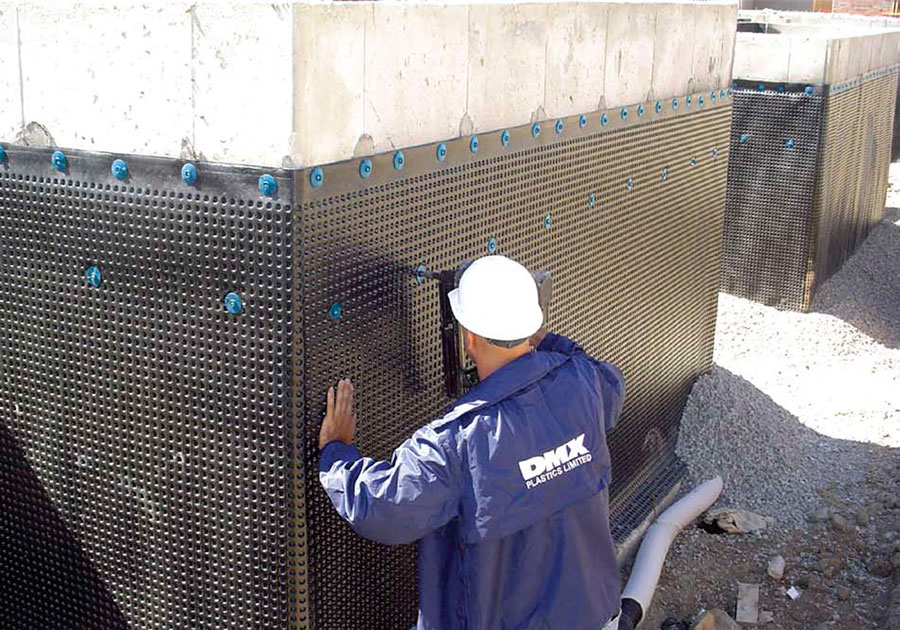
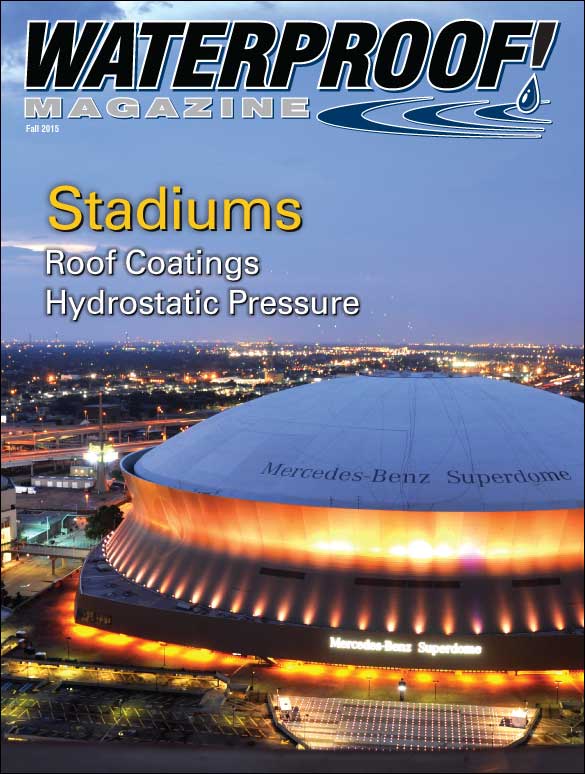

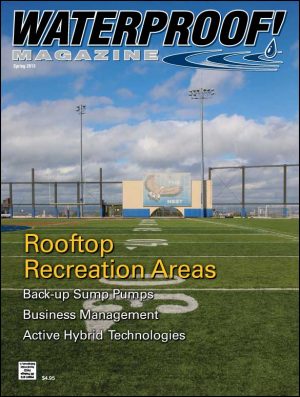


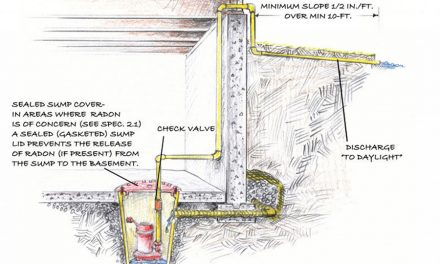
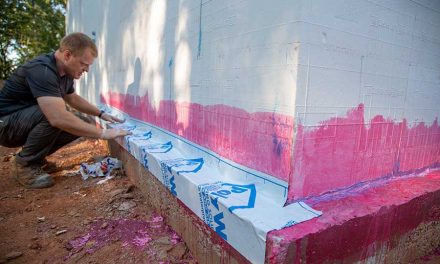
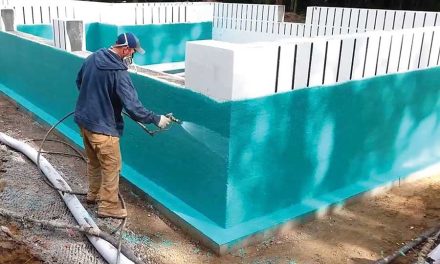
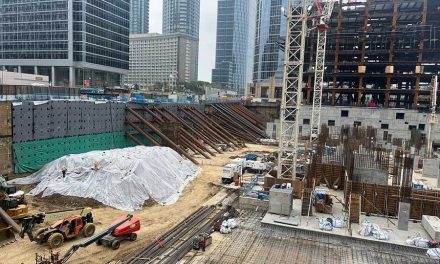









I’m doing an appraisal that has a basement with mild HYDROSTATIC PRESSURE and is starting to bow with a horizontal inflection crack or “gap”. I have to write it into the report, and they want me to make “cost to cure” which to me this seems impossible and out of the scope of the appraisal and of my professional ability, however, I am looking for a source or resource to gather this data from, if you could possibly help me to find out on a SF or Linear foot (wall length) cost ranges may run. Thank you newjerseyappraisals@gmail.com